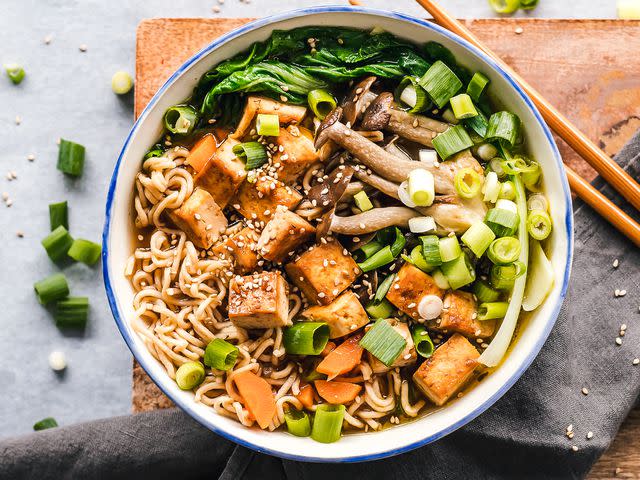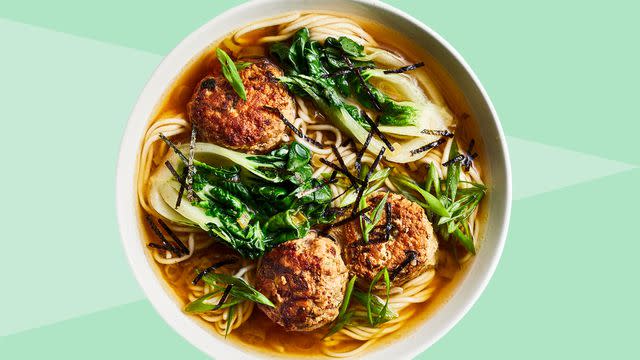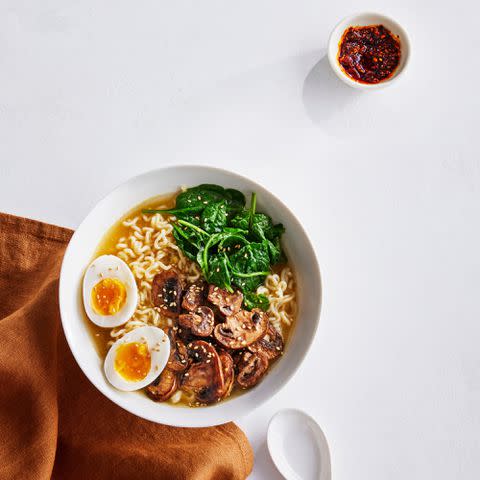How to Cook Ramen According to Pro Chefs, Plus 4 Recipes to Try
This popular brothy noodle dish is basically a blank canvas. Use our expert tips to experiment on your own, or try one of our ramen recipes.
Fact checked by Isaac WinterMedically reviewed by Kristy Del Coro, MS, RDN, LDN
Like a hug in a bowl, ramen is incredibly satisfying and flavorful, with variations that are basically infinite. No, we're not talking about the instant ramen packets popular in dorm rooms (not that they don't have their place).
We're talking about the rich and complex broth-based soup bursting with wheat noodles, meat and/or vegetables, and a variety of toppings. Ready to make some delicious ramen at home? Chefs Israel and Okochi offer their expertise in making, serving, and even eating ramen.

Ramen History
Ramen is a major part of Japanese culture, but it's presumed to have originated in China and then spread far and wide. Today, regional variations are vast and ramen components—essentially broth, noodles, and toppings—vary widely.
To throw a curveball into the mix, some ramen dishes, like mazemen, are broth-less and simply tossed in a rich sauce. Another variation, tsukemen, are cold noodles served with a dipping sauce or broth alongside for dunking.
How to Perfect Ramen Broth
When it comes to the prevalent broth-based variety, there is no wrong answer to what ramen broth can be. This is echoed by our experts, Aaron Israel and Sawako Okochi, authors of Love Japan: Recipes from our Japanese American Kitchen ($30, amazon.com) and the chef-owners of Shalom Japan in Brooklyn, New York.
Ramen broth can be made from vegetables, chicken, pork, beef, or any combination. Broth can also be fish-based or made with bonito flakes (katsuobushi), which are pink flakes of dried tuna. Traditionally it can take hours, even days, to prepare a proper ramen broth. Here's how to improve the flavors of at-home ramen broth.
Use Traditional Seasoning
What helps to further differentiate the broth base is how it's seasoned and how the salt is delivered to the broth, which is called tare. Israel and Okochi break it down further with some examples of the main types of broth seasoning:
Shio, which is salt
Shoyu or soy sauce, which lends a dark soybean flavor to the broth
Add Vinegar for Extra Flavor
Just a dash of this pantry staple balances excess richness and fattiness. As for which type of vinegar to use, serve your ramen bowl with a mild one, like rice vinegar, on the side. (Choose a black-colored rice vinegar for a touch of drama!) This way, everyone can add a touch of acidity to their own bowl based on their preference.
Enhance a Veggie Broth
Using vegetable broth for ramen yields an overall light broth. For more flavor, add some miso for a burst of umami, or take it a step further and add a piece of dried kombu, a type of kelp.
How to Make Excellent Ramen Noodles
Beyond the broth, there are (of course) chewy wheat-based noodles that can be thin or thick, wavy or straight, and dried, fresh or frozen. Not long ago, if you wanted to make ramen at home, you had to rely on dried noodles. Today, you can find fresh and frozen ramen noodles at Asian food stores and many supermarkets. Sun Noodle is one of the most popular brands.
What's certain is that it's not ramen without the noodles. (Fun fact: "men" means noodles in Japanese.) Sure, there's more to ramen than some scrumptious broth and comforting carbs, but here's how to make the most of every noodle.
Learn Ideal Noodle Types
A good rule of thumb for choosing ramen noodles is to consider them as a vehicle for the broth. The heavier (or more clingy) the broth you're using, the thicker the noodle should be. For a broth that's very rich and heavy, you want less broth in each bite, so a thicker noodle is best because the broth just coats the exterior of the noodle and more broth slides off.
The lighter the broth, the thinner and wavier the noodle should be. The rationale is that a thinner, wavier noodle carries more broth in each bite. Thin noodles are great for a chicken-based broth, for example, but go a little thicker as the broth gets heavier.
Despite the "rule," if you like a thicker noodle (regardless of the broth), use it. Remember that our experts say "there's no wrong answer."
Wait to Cook Noodles
When using fresh noodles, wait to cook them until you're really ready to serve and eat them. When cooked noodles sit in the broth too long, they overcook and absorb the broth, leaving bowls with less broth.
Cook Noodles in Fresh Water First
Another noodle tip: Always cook fresh noodles separately in boiling water for a minute or two, and then add them to the broth. Here's why: Ramen noodles are made with an ingredient like sodium carbonate, which is partly responsible for their springy, chewy texture. If you don't want this ramen noodle component altering the clarity of your broth, cooking fresh noodles wholly in broth is not a shortcut to take.
Topping Ideas
The finishing touch in a bowl of ramen is the toppings, and the possibilities are deliciously endless. Here are only a few of many popular ramen toppings:
Japanese braised pork belly (chashu) or roasted pork loin, thinly sliced.
Soft-boiled egg (half or whole) with a runny or jammy yolk. For extra flavor, marinate the egg in a soy sauce mixture (see our instructions below).
Chopped or sliced scallions for a refreshing kick.
A thin, triangle-shaped sheet of dried seaweed (nori) tucked into the broth for dipping, or a garnish of shredded seaweed.
Fish cake (kamaboko), an eye-catching pink and white topping made of fish paste. It's often a thin, circular slice with scalloped edges and a pink swirl in the center (narutomaki).
Bean sprouts, blanched or stir-fried.
Bamboo shoots (menma), a dried, fermented, seasoned condiment about 2 to 3 inches long and ½ inch wide.
Bok choy, cooked and often halved or quartered longwise through the stem.
Mushrooms, most commonly shiitake, wood ear, or enoki.
Try a Garlic Chili Oil Topping
For a toasted garlic and sesame flavor, top your ramen bowl with a light drizzle of garlic chili oil. (S&B Crunchy Garlic with Chili Oil is a favorite brand.) This condiment's spiciness also lends a kicky flavor to the broth.
How to Soft Boil an Egg for Ramen
For the perfect jammy, soft-boiled egg to serve with ramen, follow this procedure:
Drop large eggs into boiling water.
Cook for 6 minutes.
Rinse in cold water to stop the cooking.
Peel eggs and serve, halved or whole, atop a bowl with noodles and broth.
Marinate Eggs With a Soy Sauce Mixture
Alternatively, opt for ramen eggs, which are delicious marinated eggs. To make these, cook eggs as described above, and then marinade peeled eggs in equal parts soy sauce, sugar, and mirin for between 15 minutes and 3 hours. For ramen eggs, the white darkens, and the yolk gets a little gummy and less runny as the marinade pulls moisture from it.
Serve Ramen Like a Pro
Just before serving, make sure everyone is ready to eat, every topping is chopped, and everything is ready to go at once. Here's the proper sequence:
Get the water boiling for the noodles, and have the broth piping hot.
Add noodles to the boiling water and give them a stir so they don't clump together.
While the noodles are cooking, add hot broth to each serving bowl.
Drain the noodles (no need to rinse) and add to each bowl of broth. Stir the noodles to avoid clumping here, too.
Add toppings and serve.
Slurp Away!
To enjoy ramen as the Japanese do, hold the bowl up close to your mouth. Start with a few sips of the unctuous broth, and then heartily and quickly—ideally within 5 minutes—slurp down the noodles without distraction.
Yes, literally and unapologetically slurp when you eat ramen! It's not just satisfying, it's actually customary and encouraged by our pros. Turns out that slurping cools the noodles and enhances their flavor as you suck steaming air into your mouth.
Delicious Ramen Recipes to Try
Now that you're equipped with top-notch pointers, it's time to try these simple, tasty ramen recipes.
Pork Ramen Soup

This speedy dinner calls on boneless pork chops for a weeknight-friendly ramen. Pork drippings, along with scallions and ginger, flavor the soy sauce-spiked chicken broth. If you swap the dry ramen noodles with fresh, remember to cook the fresh noodles in a separate pot of boiling water.
Ginger Meatball Ramen With Greens and Scallions

Flavorful pork meatballs seasoned with fresh ginger, scallions, and soy sauce take this bowl of ramen to another level. Meatballs aren't traditionally in ramen, but these juicy ones work perfectly with the chewy noodles and the miso-soy sauce-spiked broth. Cook the noodles separately if you're using fresh ones.
Thai Peanut Butter Ramen

Remember that bit about broth-less ramen? This is one to try. Its noodles are coated with a rich, spicy peanut butter sauce seasoned with soy sauce, resulting in a flavor-packed meal. Fresh ramen noodles make this recipe even more delicious.
Miso-Mushroom Ramen With Jammy Eggs

This vegetarian version is decidedly not short on flavor thanks to umami-rich miso, cremini mushrooms, ginger, and garlic. It's topped with a 7-minute egg, baby spinach leaves, a drizzle of sesame oil, and a sprinkle of sesame seeds. Happy slurping!
For more Real Simple news, make sure to sign up for our newsletter!
Read the original article on Real Simple.

